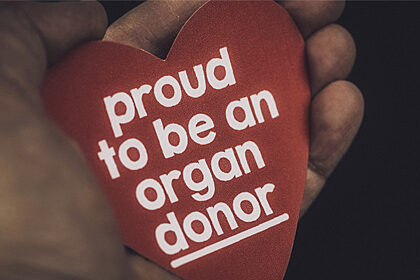The Gift That Keeps On Giving

 Valentine’s Day is a time for loving, sharing and caring. We know what this means in the romantic sense, but what if there were a more meaningful way to celebrate the holiday?
Valentine’s Day is a time for loving, sharing and caring. We know what this means in the romantic sense, but what if there were a more meaningful way to celebrate the holiday?
Feb. 14, 2020 marks the 22nd annual National Donor Day, a day dedicated to spreading awareness about organ donation. National Donor Day focuses on more than traditional organ donation, highlighting the importance of tissue, marrow, platelets and blood donations.
Stephan Moore, UF Health Shands Transplant Center program director, has witnessed the impact of organ donation throughout his nearly seven years in the position. He has watched the program expand to new heights as the need for organ donors has continued to grow.
Right now, the demand outweighs the supply, leaving patients in dire need of organs without enough donors to contribute. As of July 2019, over 113,000 people are on the national transplant waiting list. With a list this massive and not enough organs to support it, an average of 20 people die each day waiting for a transplant.
While 85% of adults in the United States support organ donation, only 58% are registered as donors. Because many people are hesitant to become a registered organ donor based on misconceptions, the goal of National Donor Day is to close this gap through increased awareness and education. Some potential donors find the thought morbid, even though in 2018, over 6,830 transplants were from living donors who were able to contribute an organ, like a kidney, or portion of an organ, like a lobe of their liver. Others might think that one person registering can’t make much of a difference, but one donor can save eight lives or more by contributing organs such as the heart, pancreas, intestines, lungs, kidneys and liver (which in some cases can be dissected for two recipients), as well as eyes, skin, tissue and more. Organ donations aren’t just benefiting older sick people, either. Young individuals are also in need of organs for a chance to live life to the fullest.
“We’ve had patients experience strange reactions while giving birth that mess up their lungs. Lung transplants have been able to save lives of young ladies with young children, and allow people to take care of their families,” Moore said. “Transplants really allow people to get back to a normal life.” Not only does organ donation save patients’ lives, it often helps grieving families to heal.
“Once the donor family gets past the trauma of losing their loved one, they come to the realization that someone was helped through their tragedy,” Moore said. “I get to read some of the letters that donor families receive from recipients, and many of them find comfort in knowing that somebody was helped through their loss.”
To learn more about how to register and advocate for organ donation, visit UF Health Shands Transplant Center for resources.
About the author
